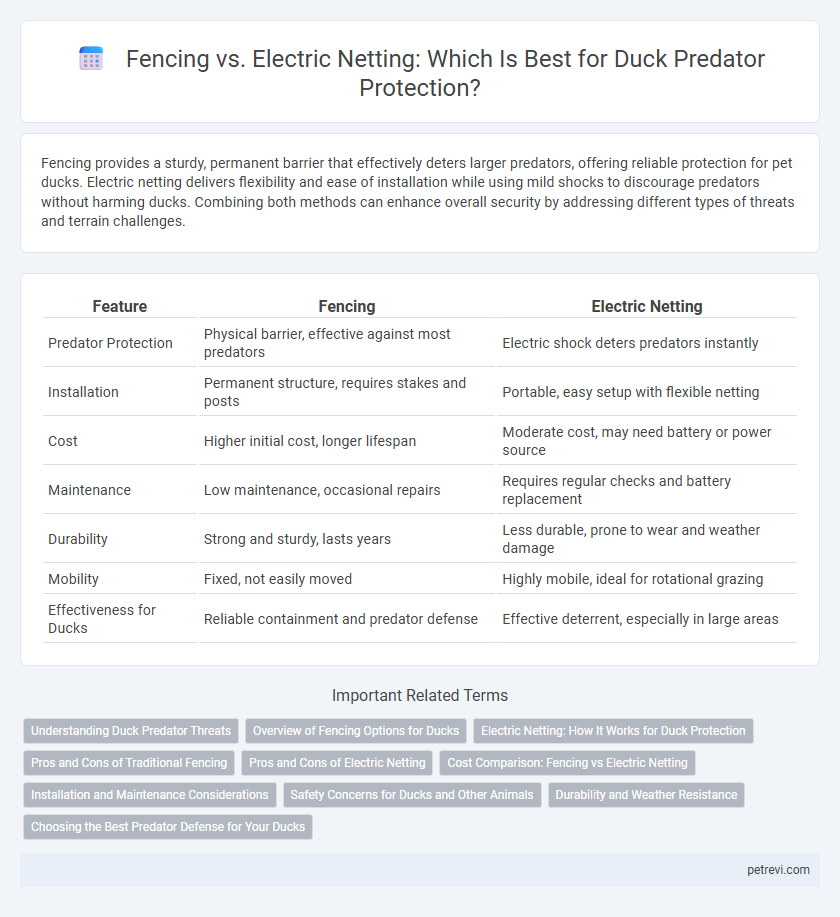Fencing provides a sturdy, permanent barrier that effectively deters larger predators, offering reliable protection for pet ducks. Electric netting delivers flexibility and ease of installation while using mild shocks to discourage predators without harming ducks. Combining both methods can enhance overall security by addressing different types of threats and terrain challenges.
Table of Comparison
| Feature | Fencing | Electric Netting |
|---|---|---|
| Predator Protection | Physical barrier, effective against most predators | Electric shock deters predators instantly |
| Installation | Permanent structure, requires stakes and posts | Portable, easy setup with flexible netting |
| Cost | Higher initial cost, longer lifespan | Moderate cost, may need battery or power source |
| Maintenance | Low maintenance, occasional repairs | Requires regular checks and battery replacement |
| Durability | Strong and sturdy, lasts years | Less durable, prone to wear and weather damage |
| Mobility | Fixed, not easily moved | Highly mobile, ideal for rotational grazing |
| Effectiveness for Ducks | Reliable containment and predator defense | Effective deterrent, especially in large areas |
Understanding Duck Predator Threats
Duck predator defense requires recognizing common threats such as foxes, raccoons, coyotes, and birds of prey, which vary in size, agility, and attack methods. Fencing provides a physical barrier that can effectively block larger ground predators, while electric netting offers a flexible, shock-delivering perimeter deterring both ground and aerial attackers. Evaluating local predator behavior and terrain helps determine the most suitable option for protecting ducks from specific threats.
Overview of Fencing Options for Ducks
Fencing options for duck predator defense include traditional wire fences and modern electric netting, each offering distinct advantages. Wire fences provide a sturdy, long-lasting barrier effective against larger predators, while electric netting offers a flexible, lightweight solution that delivers mild shocks deterring a wider range of threats. Selecting the appropriate fencing depends on factors such as predator type, terrain, and ease of installation, ensuring optimal protection for ducks.
Electric Netting: How It Works for Duck Protection
Electric netting creates a low-voltage barrier that delivers a mild shock to deter predators from accessing duck enclosures, effectively preventing attacks without harming wildlife. The portable, lightweight design allows for easy setup and relocation, making it suitable for dynamic farming environments. Its conductive mesh and insulated posts ensure consistent electrification, enhancing security for ducks throughout their roaming or resting periods.
Pros and Cons of Traditional Fencing
Traditional fencing offers strong physical barriers that effectively deter larger predators like foxes and raccoons from accessing duck enclosures. However, these fences can be costly to install and maintain, often requiring regular repairs due to weather damage or predator attempts to breach the barrier. Unlike electric netting, traditional fencing lacks flexibility and rapid setup, potentially limiting its effectiveness in variable terrain or temporary setups.
Pros and Cons of Electric Netting
Electric netting offers efficient protection against duck predators by creating a visible and physical barrier that deters foxes, raccoons, and other common threats. It is lightweight, portable, and easy to set up, making it ideal for temporary or rotating enclosures. However, electric netting requires a power source, regular maintenance to ensure electrification, and can pose a risk of injury to non-target animals or humans if not properly managed.
Cost Comparison: Fencing vs Electric Netting
Traditional fencing for duck predator defense typically involves a higher initial investment, ranging from $5 to $15 per linear foot, due to materials like wooden posts and wire mesh. Electric netting offers a more cost-effective solution with prices around $1 to $3 per linear foot, but requires ongoing expenses for batteries or solar panels and occasional maintenance. When evaluating long-term costs, electric netting may provide better value by combining affordable setup with enhanced deterrent effectiveness against predators.
Installation and Maintenance Considerations
Fencing offers a sturdy, long-term barrier against duck predators with relatively straightforward installation using posts and wire mesh, but it requires regular inspection for damage and potential gaps. Electric netting provides a flexible, lightweight option that can be quickly set up and relocated as needed, though it demands consistent maintenance to ensure electrical functionality and battery or power source reliability. Both methods require routine clearing of vegetation around the perimeter to preserve effectiveness and minimize predator access.
Safety Concerns for Ducks and Other Animals
Fencing provides a sturdy physical barrier that effectively deters predators without posing electrical hazards to ducks or other animals nearby. Electric netting offers a more flexible and portable solution but carries risks of injury or stress to ducks if improperly installed or maintained. Ensuring proper voltage settings and regular inspections are critical to balance predator deterrence with the safety of all animals involved.
Durability and Weather Resistance
Electric netting offers superior durability and weather resistance compared to traditional fencing, with UV-stabilized materials that withstand prolonged exposure to sun, rain, and wind. Its lightweight yet strong polymer mesh resists rust and corrosion, extending its lifespan in harsh outdoor conditions. Traditional fencing, often constructed from metal or wood, may degrade faster due to rust, rot, or warping when exposed to moisture and extreme temperatures.
Choosing the Best Predator Defense for Your Ducks
Fencing provides a robust physical barrier that deters larger predators such as foxes and raccoons, often made of galvanized wire mesh with enterrust designs customized for ducks. Electric netting offers a flexible, portable solution delivering a mild shock to deter predators like stray dogs and coyotes without harming the ducks. Choosing the best defense depends on factors including predator type, terrain, and ease of access, ensuring optimal protection by combining durability and effective deterrence tailored to your duck management.
Fencing vs Electric Netting for Duck Predator Defense Infographic

 petrevi.com
petrevi.com